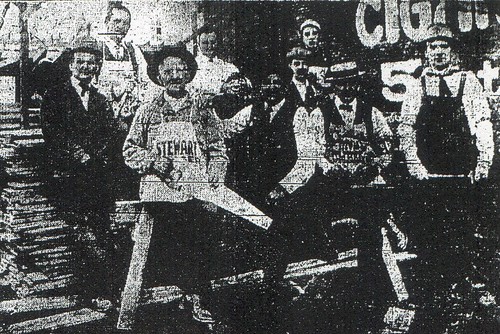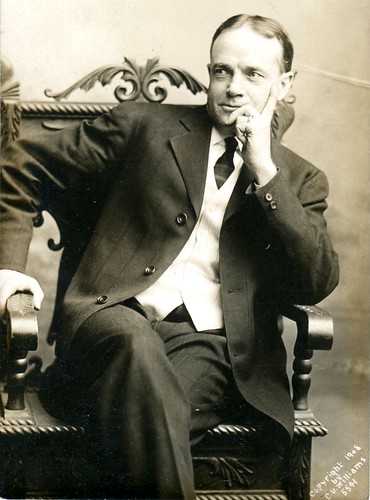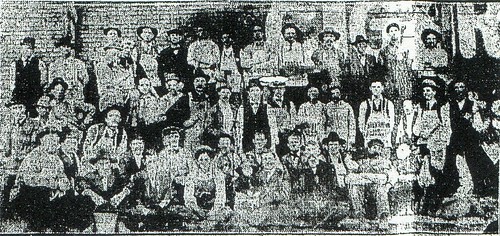Fifty Days of Sunday
Billy Sunday and the Building of the Tabernacle
In the days leading up to the 2nd of November, excited rumors had filled the streets and the pews of Joplin with the pending arrival of one of America’s most pre-eminent Evangelical preachers, Reverend Billy Sunday. Rumors and promises had been many, but the hushed excitement burst into complete reality with the arrival of his manager two weeks earlier, Albert P. Gill, to make all necessary arrangements for his employer’s future arrival and to oversee the construction of a tabernacle. Construction began early with a volunteer work force on a vacant plot of land on Virginia Avenue between Sixth and Fifth Streets. Under Gill’s watchful eye and non-too hesitant barking voice, the volunteers, many local preachers and ministers, began the process of building the future home for Reverend Sunday’s meetings in Joplin.

Front Row: Rev. C. L. Parker, First Congreational church, Rev. George H. Williamson, Bethany Presbyterian church, A.P. Gill, “advance man” for Billy Sunday, Rev. Sherman, North Heights Presbyterian church, Rev. W. M. Cleveland, First Presbyterian church. Back Row: Rev. Frank Neff, First Methodist church, Rev. E.W. Eayer, Byers Avenue Methodist church, Mr. Gravette, Secretary of YMCA, Rev. R.C. Walker, East Joplin M.E. church.
By 1909, Billy Sunday was already on his way to reaching height of his popularity in the United States. Born a poor farm boy in Iowa, William A. Sunday had first reached the national spotlight not from behind a pulpit, but on the baseball field. A successful National League player, Sunday had thrilled crowds with fantastic speed which resulted in amazing catches in the outfield and to stealing bases in the infield. In the late 1880s, however, Sunday quite literally found religion when he came across a street side singing mission group and began attending church services. Upton Sinclair of The Jungle fame and pointedly not a fan of Sunday, described him in his essay “Profits of Religion,” as:
“And here is Billy Sunday, most conspicuous phenomenon of Protestant Christianity at the beginning of the twentieth century. For the benefit of posterity I explain that “Billy” is a baseball player turned Evangelist, who has brought to the cause of God the crowds and uproar of the diamond; also the commercial spirit of America’s most popular institution. He travels like a circus, with all the press-agent work and newspaper hurrah; he conducts what are called “revivals”, in an enormous “tabernacle” built especially for him in each city.”
For over fifty years, Sunday roamed from one city after another, preaching a message against the vices of the day, and passionately against alcohol. One of the strongest proponents of Abolition, Sunday wrote in his pamphlet, Get on the Water Wagon, expressing his position on alcohol:
“I am the sworn, eternal, uncompromising enemy of the Liquor Traffic. I ask no quarter and I give none. I have drawn the sword in defense of God, home, wife, children and native land, and I will never sheathe it until the undertaker pumps me full of embalming fluid, and if my wife is alive, I think I shall call her to my beside and say: “Nell, when I am dead, send for the butcher and skin me, and have my hide tanned and made into drum heads, and hire men to go up and down the land and beat the drums and say, ‘My husband, “Bill” Sunday still lives and gives the whiskey gang a run for its money.’”
Sunday saw liquor as as a “degrading influence upon the individual, upon business, upon public morals, upon the home…” and its continued existence in many communites founded upon local alcohol taxes, which prompted otherwise “dry” individuals to allow it to remain around rather than be abolished. At the same time, Joplin was a city where saloons were even with the number of churches, if not exceeding them, and a mecca for many from surrounding communities to travel to with entertainment and good times on the mind. Never had such a conflict between host and guest existed in Joplin since a visit by bar busting and axe wielding Carrie Nation several years earlier.
Requisite to any Reverend Sunday meetings was the tabernacle. A temporary, but sturdy construction designed to keep attendees dry and warm while listening to Sunday’s passionate preaching, such buildings sprang up in every city that he visited. Gill, his manager, on the morning of November 2nd, was questioned whether he and the volunteers could build the structure in five days. The manager quickly and confidently boasted that they could build it in four. By the end of the day, the skeleton of the building had been completed and the larged beamed construction towered over the former vacant lot.
Wednesday morning saw the arrival of volunteers in even greater numbers, the men “covered the building like ants and the sound of hammers could be heard for blocks. Men who came to look on absorbed the enthusiasm of the moment and joined in the work.” The men began that morning the process of building the tabernacle’s walls and roof, a process that carried on through to Friday. Communal dinners were served and followed by inspiring speeches to encourage and to thank those who worked. Old men who lacked the strength but not the will to help walked under the heat of a warm November sun from worker to worker with buckets of water to relieve their thirst. By the end of the day on Friday, all but the stage and seating inside the tabernacle had been completed. On average, fifty men and boys worked at any one time on the structure. Their ages spanned from 16 to 80 years old, and had to Gill’s proclamation built a tabernacle of its size in four days that had previously taken others ten to twelve days.
A newspaper account reported that every pastor and minister in Joplin had in some way worked on the tabernacle and for many of them it was an experience heavy on symbolism that reminded them of the temple that Solomon had ordered built in the Old Testament. The effort put into building such a structure of temporary nature was seen as a civic effort to build a foundation for a “moral temple which will last forever.” The practice of carpentry for several pastors was an experience that allowed them to relate better to the common working man and even more importantly, as one preacher noted, “…the deeper underlying thought that I was having a share in a movement that was going to mean happier homes, a re-adjustment of life on the part of many and a better Joplin…”
However, neither was the experience reflected on without humor from the preachers of Joplin who made the following quips to a reporter:
“The building of the tabernacle proves that the preachers of Joplin are capable of working their hands as well as working their jaws.”
“Personally, I’m glad that I was permitted to contribute something to the building of the tabernacle even if I did hit one nail too many — my thumb.”
“I freely confess that after the first half hour of the first day the glamor of the thing began to wear off…”
After the last nail had been hammered, the roof properly water proofed with tar paper, and the final board set in place, the tabernacle sported impressive figures for such a temporary structure. It was 175 feet long and 140 feet wide. Approximately 125,000 feet of lumber was required to construct it and over 12 kegs of nails needed to hold the timber together. Capacity was expected to be 6,500 seated attendees before a stage designed to feature a loft for a 500 member chorus of singing souls, space for pastors and their wives, and of course, a podium for the Reverend Billy Sunday. The cost was approximately $3,000 with free labor and reduced prices for the supplies or close to $70,000 in 2012 dollars.
The tabernacle featured an entrance and exit at every corner of the building and two more additional exits on each lengthy side of the building. A roof, remarked as low but excellent, was built with ventilation that also extended to the sides of the building, 200 square feet of it overall to insure fresh air was ever present. Remarkably, the tabernacle was heated by natural gas via a pipe laid around the inside of the structure with gas stoves set strategically about to burn and provide warmth. Gas was also used on large lights which hung from the ceiling among 350 electric lights. The road and alleyways outside the tabernacle were illuminated by “brilliant” arc lights.
It stood complete and empty, a condition that would soon be replaced by an almost never ending procession of religious fever, fervor and passion. For many, Joplin’s redemption was close at hand, a chance to save families, souls and to create a better city. Silent with the promises of salvation, the empty tabernacle awaited its formal dedication two weeks away, a visible reminder to all who walked along Virginia avenue that Billy Sunday was just over the horizon.
Stay tuned for more in an ongoing series about Billy Sunday’s visit to Joplin and the consequent battle over Joplin’s destiny as a dry or wet town.


